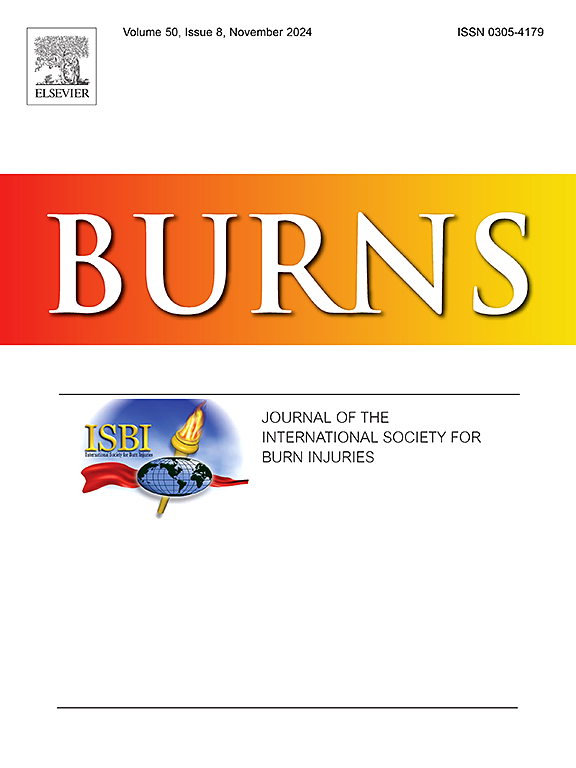Evaluation of emergency skin decontamination protocols in response to an acid attack (vitreolage)
IF 3.2
3区 医学
Q2 CRITICAL CARE MEDICINE
引用次数: 0
Abstract
The incidence of “acid attacks” (vitreolage) is a global concern, with those affected often receiving lifelong medical care due to physical and psychological damage. The purpose of this study was to evaluate the effectiveness of several emergency skin decontamination approaches against concentrated (>99 %) sulphuric acid and to identify the effective window of opportunity for decontamination. The effects of four decontamination methods (dry, wet, combined dry & wet and cotton cloth) were assessed using an in vitro diffusion cell system containing dermatomed porcine skin. Sulphuric acid (H2SO4) was applied to the skin with decontamination protocols performed at 10 s, 30 s, 8 min, and 30 min post exposure. Skin damage was quantified by tritiated water (3H2O) penetration, receptor fluid pH and photometric stereo imaging (PSI), with quantification of residual sulphur (by SEM-EDS) to determine overall decontamination efficiency. Skin translucency (quantified by PSI) demonstrated a time-dependent loss of dermal tissue integrity from 10 s. Quantification of dermal sulphur content confirmed the rapid (exponential) decrease in decontamination efficiency with time. The pH of the water effluent indicated complete neutralisation of acid from the skin surface after 90 s of irrigation. Wet decontamination (either alone or immediately following dry decontamination) was the most effective intervention evaluated, although no decontamination technique was statistically effective after 30 s exposure to the acid. These data demonstrate the time-critical consequences of dermal exposure to concentrated sulphuric acid: we find no practical window of opportunity for acid decontamination, as physical damage is virtually instantaneous.
评估应对酸攻击(玻璃体酸蚀)的紧急皮肤净化方案。
酸攻击"(玻璃酸蚀症)的发生率是一个全球关注的问题,受影响者往往因身体和心理上的伤害而终生接受医疗护理。这项研究的目的是评估几种针对浓硫酸(>99%)的紧急皮肤净化方法的效果,并确定有效的净化机会窗口。研究人员使用了一个含有经皮肤处理的猪皮肤的体外扩散细胞系统,对四种去污方法(干法、湿法、干湿结合法和棉布法)的效果进行了评估。在皮肤上涂抹硫酸(H2SO4),分别在接触后 10 秒、30 秒、8 分钟和 30 分钟执行净化方案。通过三价水(3H2O)渗透、受体流体 pH 值和光度立体成像(PSI)对皮肤损伤进行量化,并对残留硫进行量化(通过 SEM-EDS),以确定总体净化效率。皮肤半透明度(通过 PSI 定量)显示,从 10 秒钟开始,皮肤组织完整性的丧失与时间有关。对皮肤硫含量的定量证实,随着时间的推移,去污效率会迅速下降(指数式)。流出水的 pH 值表明,灌洗 90 秒后,皮肤表面的酸性物质完全中和。湿法去污(单独去污或在干法去污后立即去污)是所评估的最有效的干预措施,尽管在接触酸液 30 秒后,没有一种去污技术在统计学上是有效的。这些数据表明,皮肤暴露于浓硫酸会造成时间上的严重后果:我们发现,由于物理损伤几乎是瞬时发生的,因此酸性物质的净化没有实际的机会窗口。
本文章由计算机程序翻译,如有差异,请以英文原文为准。
求助全文
约1分钟内获得全文
求助全文
来源期刊

Burns
医学-皮肤病学
CiteScore
4.50
自引率
18.50%
发文量
304
审稿时长
72 days
期刊介绍:
Burns aims to foster the exchange of information among all engaged in preventing and treating the effects of burns. The journal focuses on clinical, scientific and social aspects of these injuries and covers the prevention of the injury, the epidemiology of such injuries and all aspects of treatment including development of new techniques and technologies and verification of existing ones. Regular features include clinical and scientific papers, state of the art reviews and descriptions of burn-care in practice.
Topics covered by Burns include: the effects of smoke on man and animals, their tissues and cells; the responses to and treatment of patients and animals with chemical injuries to the skin; the biological and clinical effects of cold injuries; surgical techniques which are, or may be relevant to the treatment of burned patients during the acute or reconstructive phase following injury; well controlled laboratory studies of the effectiveness of anti-microbial agents on infection and new materials on scarring and healing; inflammatory responses to injury, effectiveness of related agents and other compounds used to modify the physiological and cellular responses to the injury; experimental studies of burns and the outcome of burn wound healing; regenerative medicine concerning the skin.
 求助内容:
求助内容: 应助结果提醒方式:
应助结果提醒方式:


